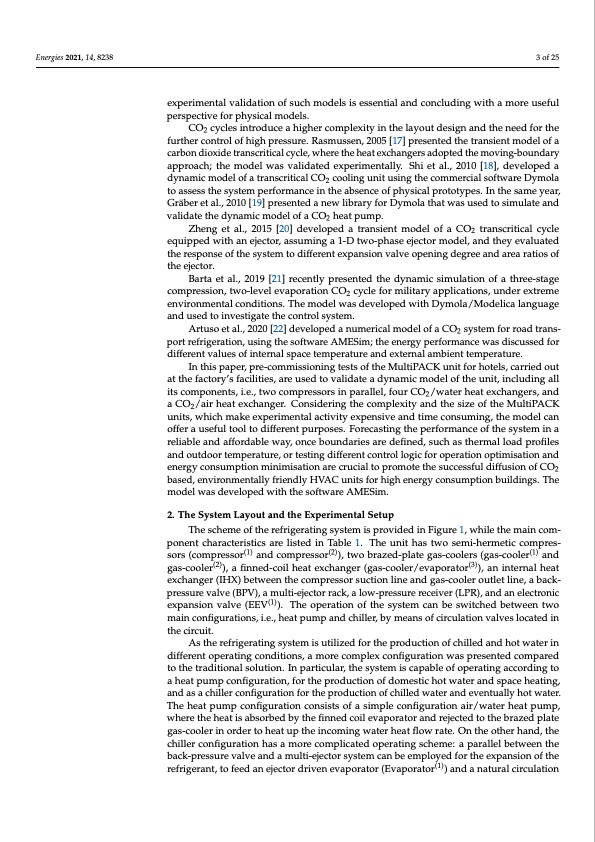
PDF Publication Title:
Text from PDF Page: 003
Energies 2021, 14, 8238 3 of 25 experimental validation of such models is essential and concluding with a more useful perspective for physical models. CO2 cycles introduce a higher complexity in the layout design and the need for the further control of high pressure. Rasmussen, 2005 [17] presented the transient model of a carbon dioxide transcritical cycle, where the heat exchangers adopted the moving-boundary approach; the model was validated experimentally. Shi et al., 2010 [18], developed a dynamic model of a transcritical CO2 cooling unit using the commercial software Dymola to assess the system performance in the absence of physical prototypes. In the same year, Gräber et al., 2010 [19] presented a new library for Dymola that was used to simulate and validate the dynamic model of a CO2 heat pump. Zheng et al., 2015 [20] developed a transient model of a CO2 transcritical cycle equipped with an ejector, assuming a 1-D two-phase ejector model, and they evaluated the response of the system to different expansion valve opening degree and area ratios of the ejector. Barta et al., 2019 [21] recently presented the dynamic simulation of a three-stage compression, two-level evaporation CO2 cycle for military applications, under extreme environmental conditions. The model was developed with Dymola/Modelica language and used to investigate the control system. Artuso et al., 2020 [22] developed a numerical model of a CO2 system for road trans- port refrigeration, using the software AMESim; the energy performance was discussed for different values of internal space temperature and external ambient temperature. In this paper, pre-commissioning tests of the MultiPACK unit for hotels, carried out at the factory’s facilities, are used to validate a dynamic model of the unit, including all its components, i.e., two compressors in parallel, four CO2/water heat exchangers, and a CO2/air heat exchanger. Considering the complexity and the size of the MultiPACK units, which make experimental activity expensive and time consuming, the model can offer a useful tool to different purposes. Forecasting the performance of the system in a reliable and affordable way, once boundaries are defined, such as thermal load profiles and outdoor temperature, or testing different control logic for operation optimisation and energy consumption minimisation are crucial to promote the successful diffusion of CO2 based, environmentally friendly HVAC units for high energy consumption buildings. The model was developed with the software AMESim. 2. The System Layout and the Experimental Setup The scheme of the refrigerating system is provided in Figure 1, while the main com- ponent characteristics are listed in Table 1. The unit has two semi-hermetic compres- sors (compressor(1) and compressor(2)), two brazed-plate gas-coolers (gas-cooler(1) and gas-cooler(2)), a finned-coil heat exchanger (gas-cooler/evaporator(3)), an internal heat exchanger (IHX) between the compressor suction line and gas-cooler outlet line, a back- pressure valve (BPV), a multi-ejector rack, a low-pressure receiver (LPR), and an electronic expansion valve (EEV(1)). The operation of the system can be switched between two main configurations, i.e., heat pump and chiller, by means of circulation valves located in the circuit. As the refrigerating system is utilized for the production of chilled and hot water in different operating conditions, a more complex configuration was presented compared to the traditional solution. In particular, the system is capable of operating according to a heat pump configuration, for the production of domestic hot water and space heating, and as a chiller configuration for the production of chilled water and eventually hot water. The heat pump configuration consists of a simple configuration air/water heat pump, where the heat is absorbed by the finned coil evaporator and rejected to the brazed plate gas-cooler in order to heat up the incoming water heat flow rate. On the other hand, the chiller configuration has a more complicated operating scheme: a parallel between the back-pressure valve and a multi-ejector system can be employed for the expansion of the refrigerant, to feed an ejector driven evaporator (Evaporator(1)) and a natural circulationPDF Image | Dynamic Modelling and Validation of an Air-to-Water Reversible R744

PDF Search Title:
Dynamic Modelling and Validation of an Air-to-Water Reversible R744Original File Name Searched:
Artuso2021dma_publisert.pdfDIY PDF Search: Google It | Yahoo | Bing
CO2 Organic Rankine Cycle Experimenter Platform The supercritical CO2 phase change system is both a heat pump and organic rankine cycle which can be used for those purposes and as a supercritical extractor for advanced subcritical and supercritical extraction technology. Uses include producing nanoparticles, precious metal CO2 extraction, lithium battery recycling, and other applications... More Info
Heat Pumps CO2 ORC Heat Pump System Platform More Info
| CONTACT TEL: 608-238-6001 Email: greg@infinityturbine.com | RSS | AMP |